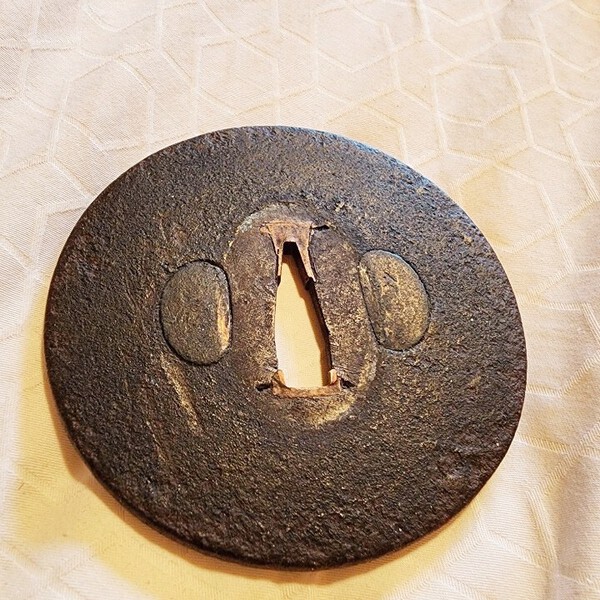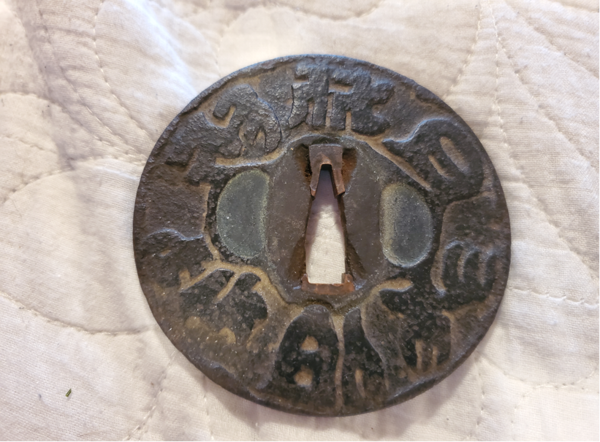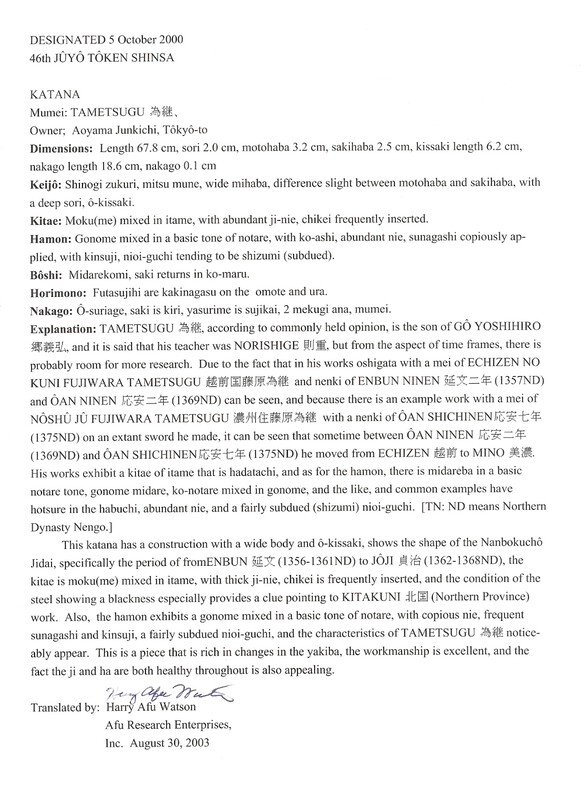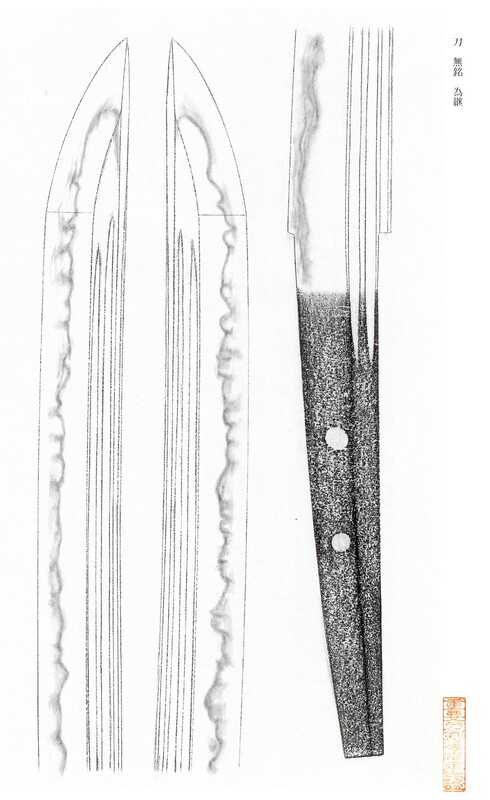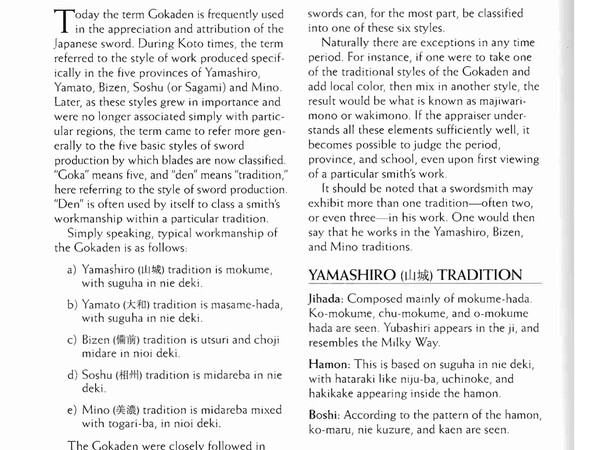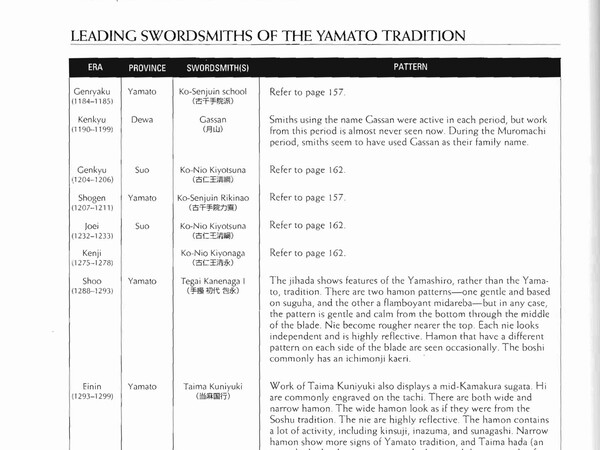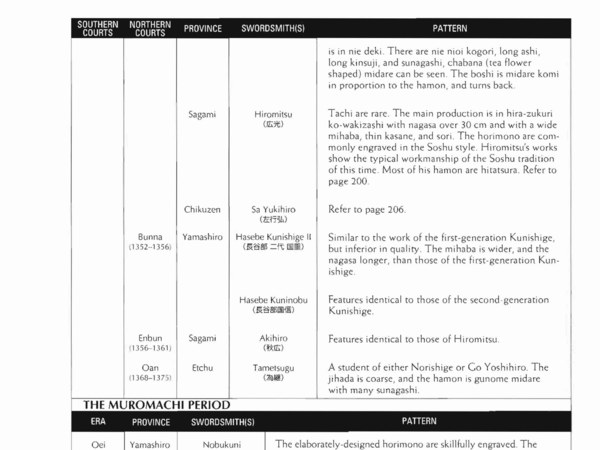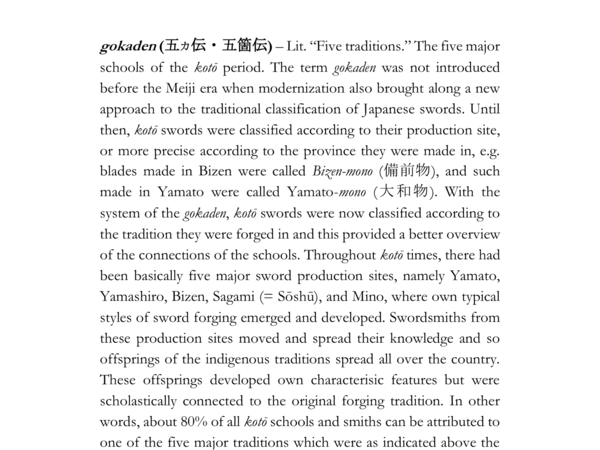-
Posts
8,632 -
Joined
-
Last visited
-
Days Won
51
Content Type
Profiles
Forums
Events
Store
Downloads
Gallery
Everything posted by Jean
-
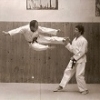
SF Cherry Blossom Festival
Jean replied to Kanenaga's topic in Sword Shows, Events, Community News and Legislation Issues
Thanks a lot Tom for all these pictures👍 -
Makes me think of Ono Yoshimitsu work
-
Ray, All the tanto I saw at DTI were sanji mei, I have never seen a niji mei tanto.
-
Late Darcy wrote something on the subject. There are two distinctive mei. A niji mei (Kunitoshi) and Sanji mei (Rai Kunitoshi), there are theories that it is the same smith. Niji mei work is wilder than the sanji mei one. I have seen quite a number of tanto signed. There are always 3-4 Juyo tanto signed at DTI. I have a doubt, but unfortunately the blade is out of polish Here are a few links to read carefully https://nihonto.com/niji-kunitoshi-二字国俊/ https://markussesko.com/2016/01/ (very interesting)
-
Dale, Many thanks, I have already inquired about the ura side but with no success, he did not send me the requested picture. I’ll try again in a minute😃
-
Here’s is an e-mail I received asking for identification : « I am a beginning tsuba collector. Maybe I should not be, since I am 70 years old. But only about a year ago I learned of what a tsuba was. Never heard of them before. Attached are the front or rear of my first tsuba. (The other side is blank.) I think it to be real from the patina and dirt on it. But after cruising the internet for over a year, I have never seen another like it. I have used some on-line charts, and think it might be a kamakura-bori type. Could you help me to identify it, if you have time.« I agree on the school, Opinions please
-
Jaron, read this topic:
-
Fantastic👍
-
Congrats
-
A big thank you first to our master without whom NMB won’t exist. He is the spider in the center of the cobweb which is NMB. A huge thanks to all the newbies with whom we share our hobby and without whom we will turn in an never ending closed circle. A big thanks to all of you who spare us John, Brian and myself, by being courteous.👍😃
- 14 replies
-
- 10
-

-

-
There is a Kaeri….
-

No sure if this is a Tomba Kami Yoshi Michi
Jean replied to kealpe's topic in Translation Assistance
https://m.japanesemeow.com/Japanese-grammar-lessons/possession-and-position-with-no/ -
Extensive article on Tametsugu showing the Soshu influence on his work. The opposite should be surprising considering his teacher. https://nihonto-com.translate.goog/echizen-no-kami-fujiwara-tametsugu-and-the-early-soshu-school-越前国藤原為継/?_x_tr_sl=en&_x_tr_tl=fr&_x_tr_hl=fr&_x_tr_pto=sc
-
The blade has Mitsu mine.
-
Jacques, As you are stuck in your books and certitudes, just ask Zénon Vandame, he saw my Gokaden at the French Token meeting a few years ago and there was no problem concerning the samples I displaid as representative of the Gokaden:
-
Jacques, Here is translation of the Juyo zufu: it is directly attributed to Tametsugu (not Den Tametsugu), rather Soshu den. You will see that Tametsugu spent quite a long time in Etchu before moving to Mino. I have no example of signed Tametsugu (Mino or Etchu), if someone can post them, I am curious to see the oshigata. I have seen quite a few blades attributed to Tametsugu, but none in Mino style. here is a link to Sanmei, where the appraiser state that this work is typically in Soshu style.(The entire quenching effect is full of variety that comes from "Nie" extremely hard metal granule activities that are typical of Soshu works in the prime of Nanbokucho period) http://sanmei.com/contents/media/T284983_S1521_PUP_E.html
-
From Nakayama Kokan: connoisseurs book of Japanese swords: you will see the definition of Gokaden. A few tables of smiths working in these traditions, it clearly shows that a smith establish in Nio province can work in Yamato tradition. It means that you don’t have to live in Yamato province to work in the Yamato tradition, the opposite being true, it is not because you live in Yamato that you have to forge in Yamato tradition (Tsutsui Kiju). page 212 - Tametsugu is classified by Nakayama Kokan as Soshu tradition
-
I let the members judge of your misconception of the Gokaden, compare to Fujishiro’s one.🙂 concerning Sho-Shin site, I made a screen copy of Shinto Yamato province smiths to show you that, as rookie as I am, I was slightly aware that Koto Yamato tradition carry on in Shinto 😂 you will notice that some even indulge to the time fashion (Toran Ba). Taking into account the number of O suriage blades kanteied by NBTHK to Kanemitsu, somewhere these blades must have included typical Bizen kantei points. Which leads to the main problem : When you are talking about tradition I am afraid you are mixing Provinces tradition and schools, otherwise how can someone speak of Bizen tradition when there are so different schools, same for Yamato with its 5 schools, Yamashiro …. and I don’t even dare to speak of Mino with Kinju and the Seki schools and Kaneuji schools… I will end here the controverse.
-
« As for the "gokaden" we can only talk about them for the first generations » « To believe that there can be no continuity in certain schools is a mark of ignorance » The problem, Jacques, is that you have a total misconception of the Gokaden. Marius Sesko in its encyclopedia has a very good article on Gokaden (pg 77). To begin with Gokaden means 5 traditions. You cannot talk of tradition with one individual, it is ridiculous. in order for you to understand what means Gokaden, you will find attached a copy of what wrote Markus. Concerning Yamato, the discussion was about signed Yamato swords. During Kamakura and Nambokucho, the temples had their own forges, swords were manufactured for the community (warrior monks) so there were no necessity to sign them. Reason why the signed Yamato blades are scarce. two facts: Shinto Yamato schools are not all following Koto Yamato schools (it is an understatement) meaning Yamato den. Shinto swords whatever the provinces are signed at 99%, reason why it has no signification to compare the number of Koto Yamato blades signed and Shinto ones. http://www.sho-shin.com/shinto-yamato.html
-
Jacques, Well tried but irrelevant. We are talking about Koto and Gokkaden. In Shinto exit the Gokkaden. In Shinto, blades were signed, warrior monks had disappeared. BTW, yes Darcy was right, this was confirm by Jussi.
-

WW2 Japanese Gunto Katana Signed Tadayoshi
Jean replied to Swords's topic in General Nihonto Related Discussion
The question is not is it worth 2000$ for you guys, but is it worth 2000$ for your eyes. You are the only one who can decide. Nobody can take the decision for you.


